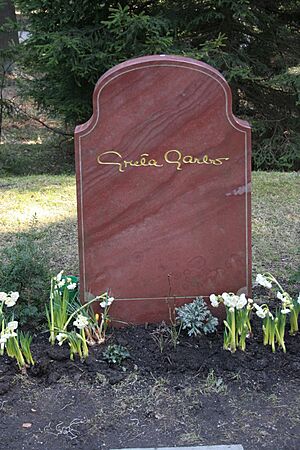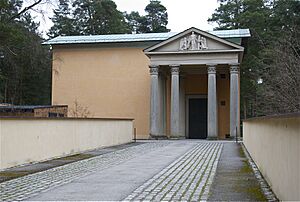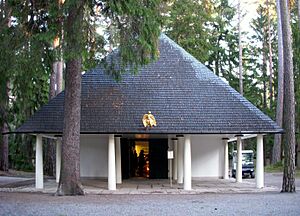Skogskyrkogården facts for kids
| UNESCO World Heritage Site | |
|---|---|
 |
|
| Location | Gamla Enskede, Stockholm Municipality, Sweden |
| Criteria | Cultural: (ii), (iv) |
| Inscription | 1994 (18th Session) |
| Area | 108.08 ha (0.4173 sq mi) |
Skogskyrkogården (which means "The Woodland Cemetery" in Swedish) is a special cemetery located in the southern part of Stockholm, Sweden. It opened in 1920 and became a UNESCO World Heritage Site in 1994. This means it's considered a very important place for everyone in the world to protect.
Two famous architects, Gunnar Asplund and Sigurd Lewerentz, designed it. Their design shows how architecture changed from a classic, traditional style to a more modern and practical style. The cemetery is known for its beautiful blend of nature and buildings.
Contents
History of Skogskyrkogården
How the Woodland Cemetery Was Created
The idea for Skogskyrkogården started with a big international competition in 1915. They needed a new cemetery for Stockholm. Two young architects, Gunnar Asplund and Sigurd Lewerentz, won with their design called "Tallum."
Work began in 1917 on land that used to be old gravel pits. These pits were covered with pine trees. The first part of the cemetery was finished three years later. The architects used the natural landscape to create a peaceful and beautiful place. This design had a huge impact on how cemeteries were built all over the world.
Inspiration for the Design
The architects got ideas from German forest cemeteries. These included places like Friedhof Ohlsdorf in Hamburg and Waldfriedhof in Munich. They also found inspiration in the paintings of Caspar David Friedrich. His art often showed nature and deep feelings.
Exploring the Cemetery's Paths
The cemetery has a main path that starts at a grand entrance with columns. This path then splits into two different routes. One path goes through a calm, park-like area with a large pond. It also has a hill perfect for quiet thinking, surrounded by trees.
The other path leads up to a large granite cross. This cross is very striking. It also leads to the crematorium and three chapels: the Holy Cross, Faith, and Hope chapels. Later, these paths join back together. They lead down a straight path through a thick forest of tall pine trees. This part is called the "Way of Seven Wells." It ends at the "Uppståndelsekapellet," or Resurrection Chapel.
The giant dark granite cross is a key feature. It can be seen from the main entrance. It was inspired by a painting by Caspar David Friedrich called "Cross on the Baltic Sea." This painting showed hope in a lonely world. However, Asplund and Lewerentz wanted the cross to be meaningful to everyone. They said it could be a comfort to those who saw it that way, or simply a cross to others.
Buildings and Art at Skogskyrkogården
The architects designed everything in the cemetery. This included the landscape, the buildings, and even small details like lamps. There are also sculptures by the artist Carl Milles.
Lewerentz mainly focused on the landscape design. He also designed the main entrance and the classical Resurrection Chapel, built in 1925. Asplund focused more on the buildings. His small Woodland Crematorium, built between 1935 and 1940, is considered one of his most important works. It also shows the style of Nordic Classicism from that time.
The crematorium includes the Faith, Hope, and Holy Cross Chapels. This was Asplund's last architectural project. It was designed in a modern, practical style. It opened shortly before he passed away in 1940.
World Heritage Status and Visitors
In 1994, Skogskyrkogården was named a UNESCO World Heritage Site. While it doesn't have as many famous people buried there as some older cemeteries in Stockholm, it's a popular place for tourists.
Visitors can go to the Tallum Pavilion. This building was originally designed by Asplund for staff. Now, it has an exhibition about the cemetery. You can learn about its history and the two architects who created this amazing place.
Skogskyrkogården is easy to reach. It has its own metro station with the same name.
Notable People Buried Here
Many interesting people are buried or remembered at Skogskyrkogården. Here are a few:
- Artur Adson (1889–1977), an Estonian poet and writer.
- Gunnar Asplund (1885–1940), one of the architects who designed the cemetery.
- Tim Bergling (1989–2018), a famous musician and DJ known as Avicii. His funeral was here, but his remains are buried elsewhere.
- Brasse Brännström (1945–2014), a well-known actor.
- Greta Garbo (1905–1990), a legendary actress from the Golden Age of Hollywood.
- Pelle Lindbergh (1959–1985), a hockey goalie who played for Team Sweden and the Philadelphia Flyers.
- Ivar Lo-Johansson (1901–1990), a Swedish writer.
- Molla Mallory (1884–1959), a tennis champion who won many titles.
- Lennart "Nacka" Skoglund (1929–1975), a famous football star.
- Marie Under (1883–1980), an Estonian poet.
- Lars-Göran Petrov (1972–2021), a singer for the band Entombed. His grave site became a special place for fans.
Images for kids











